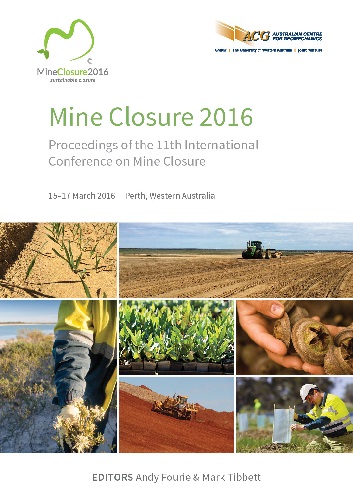A comparative study of regulatory approaches to mine closure with a special emphasis on the current situation in the former Soviet Union

|
Authors: Faizuldayeva, Z |
DOI https://doi.org/10.36487/ACG_rep/1608_25_Faizuldayeva
Cite As:
Faizuldayeva, Z 2016, 'A comparative study of regulatory approaches to mine closure with a special emphasis on the current situation in the former Soviet Union', in AB Fourie & M Tibbett (eds), Mine Closure 2016: Proceedings of the 11th International Conference on Mine Closure, Australian Centre for Geomechanics, Perth, pp. 355-367, https://doi.org/10.36487/ACG_rep/1608_25_Faizuldayeva
Abstract:
Successful mine closure or reclamation processes have various definitions in jurisdictions around the world. Setting criteria for a successful mine closure is required to measure progress towards achieving the objectives of closure. The majority of existing guidelines are based on processes – methods and procedures and techniques – the ‘means’ rather than the ‘ends’. Current debate argues that identification of end-use is good practice in mine closure methodology, seeking outcomes such as future use, performance and function. This paper examines aspects of these ‘good’ mine closure practices, identifying the objectives and criteria in the jurisdictions of Western Australia, Canada (BC), Chile and South Africa. This paper then goes on to contrast these aspects with what is currently found in former Soviet Union (FSU) countries of Russia, Kazakhstan and Kyrgyzstan. It is apparent that these FSU countries have much to do to achieve good mine closure practices. The paper concludes with descriptions of planned future development of policies and trends in the FSU arena that could move towards targeting similar good practices.
Keywords: closure objectives, criteria, FSU, good industry practice
References:
Banks Act 1990, Act No. 94 of 1990, Government Notice 1597 in Government Gazette 12617.
Barton, C 2013, Mine site closure in WA and the Rehabilitation Fund, Norton Rose Fulbright, August 2013.
BC TRCR (The British Columbia Technical and Research Committee on Reclamation) 2010, Mining in BC, The British Columbia Technical and Research Committee on Reclamation, British Columbia.
Bogdetsky, V & Novikov, V 2012, Mining, Development and Environment in Central Asia: Case Studies. A Toolkit Companion, University of Eastern Finland, Gaia Group Oy.
Brokering Abogados c. 2015, Law concerning the closure of mining facilities, viewed on 27 October 2015,
DMP (Department of Mines and Petroleum) 2015, Mining Rehabilitation Fund (MRF), Department of Mines and Petroleum & Environmental Protection Authority, Western Australia.
DMP & EPA (Department of Mines and Petroleum & Environmental Protection Authority) 2015, Guidelines for Preparing Mine Closure Plans, Department of Mines and Petroleum & Environmental Protection Authority, Western Australia.
Dorian, JP, Minakir, PA & Borisovich, VT (eds) 1993, Introduction and background, CIS Energy and Minerals Development, The GeoJournal Library, vol. 25.
Ellman, M 1979, Socialist Planning, Cambridge University Press, Cambridge, England, p. 17.
EPA (Environmental Protection Authority) 2015, Environmental Assessment Guideline for Environmental principles, factors and objectives, Environmental Protection Authority, Western Australia.
Gullette, D & Kalybekova, A 2014, Agreement under Pressure Gold Mining and Protests in the Kyrgyz Republic, FriedrichEbertStiftung, Department of Central and Eastern Europe, Berlin.
Honkonen, T 2012, Environmental Security, Mining and Good Governance: Mining Regulation in the Kyrgyz Republic – A Review, Zoï Environment Network, University of Eastern Finland, Gaia Group Oy.
Law 19.300 1994, The General Framework Law on the Environment, 9 March, the Official Gazette (Diario Nacional).
McLaren, G 2008, ‘Mine Reclamation and the British Columbia Environmental Assessment Process’, British Columbia Mine Reclamation Symposium, the British Columbia Technical and Research Committee on Reclamation (TRCR).
Province of British Columbia c. 2015, British Columbia Mine Reclamation Securities, Government of British Columbia, Vancouver, Canada.
Olivari, A 2014, ‘Financial assurance for mine closure in Chile’, in Proceeding of Mine Closure Solutions 2014, InfoMine.
Rajaram, R 2005, ‘Chapter 3: Issues in Sustainable Mining Practices’, in Sustainable Mining Practices — A Global Perspective, A.A. Balkema Publishers, a member of Taylor & Francis Group: Leiden, The Netherlands, pp. 45–89.
Sanzana, E, Weeks, B & Fernandez, S 2015, ‘Closure planning for the largest copper producer in the world’, Mine Closure 2015, InfoMine Inc., Canada.
Saxe, D & Campbell, J 2015, Canadian environmental law introduction, Saxe Law Office, Environmental Law, viewed on 19 August 2015,
Siwik, R & Clemens, M 2015, ‘Mine closure – past, present and perpetuity’, Mine Closure 2015, InfoMine Inc., Canada.
Slocombe, D 2012, ‘Exploring the origins of ‘social license to operate’ in the mining sector: Perspectives from governance and sustainability theories’, Resources Policy 37, pp. 346–357.
Vershinina, E 2003, ‘Land rehabilitation requirement and practices in Russia’, SRK Consulting’s International Newsletter No. 45.
USGS (U.S. Geological Survey) 2012a, Minerals Yearbook 2012 — Kazakhstan, Reston, Virginia, USA.
USGS (U.S. Geological Survey) 2012b, Minerals Yearbook 2012 — Russia, Reston, Virginia, USA.
Waggit, P 2008, ‘Uranium mining legacies remediation and renaissance development: an international overview’, Uranium, Mining and Hydrogeology, vol. XXII, viewed 27 October 2015, Springer Database, p. 958.
© Copyright 2025, Australian Centre for Geomechanics (ACG), The University of Western Australia. All rights reserved.
View copyright/legal information
Please direct any queries or error reports to repository-acg@uwa.edu.au
View copyright/legal information
Please direct any queries or error reports to repository-acg@uwa.edu.au